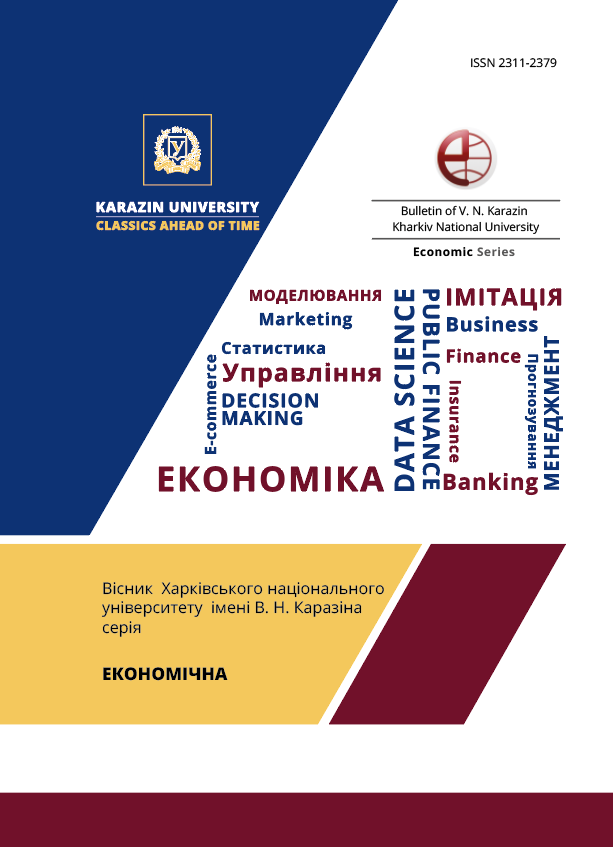Models for evaluation of resistance of macroeconomic systems to exogenic "shocks"
Abstract
The article proposes an approach to the development of models for assessing the resilience of macroeconomic systems to the effects of exogenous shocks with an emphasis on the study of assessing the resilience of diagnostic classes. The relevance of the chosen research topic is explained by the fact that the development of the world economy takes place in the context of increasing globalization processes. In this economic environment, both positive and negative effects of these processes are formed. Due to the inability to control the impact of external destabilizing factors, there is a problem of assessing the resilience of the economy to "shocks" elements. Consideration of thematic, literature sources allowed to confirm the importance of the stated research and insufficient elaboration of the issues of assessing the stability of cluster formations. The aim of the article is to develop classification models that, based on hierarchical agglomerative methods of cluster analysis, iterative methods of cluster analysis, Kohonen neural networks, allow to analyze the stability of macroeconomic systems cluster formations, analyze the migration of elements from cluster to cluster systems to the action of exogenous shocks. The main objectives of the study were to develop models for classifying countries according to the level of resistance to exogenous "shocks" based on agglomeration methods of cluster analysis, iterative methods of cluster analysis, Kohonen neural networks; assessment of the classification quality, justification of the choice of the final breakdown; analysis of migration from cluster to cluster, assessment of structural dynamics. The obtained results allowed us to conclude that Kohonen neural networks provide an opportunity to obtain a better and more economically interpreted classification taking into account the models of crisis development in the element countries prone to migration from cluster to cluster. Analysis of the structural dynamics of clusters in the pre-crisis, crisis, post-crisis period shows a decrease in global stability, as there is a high proportion of countries with medium and low resistance to exogenous "shocks", as well as migration of many elements to the lower cluster in the post-crisis period. The analysis of cluster characteristics showed that for countries with a low level of resistance to exogenous "shocks" the critical subsystem is the financial security subsystem, which requires the transformation of protection mechanisms for financial "contagion". The obtained results can be used in systems of proactive crisis management.
Downloads
References
KOF Globalisation Index. (2022). Retrieved from https://kof.ethz.ch.
FINVIZ. Financial visualizations. (2022). Retrieved from https://finviz.com.
FRED Graph. Unemployment Rate. (2022). Retrieved from https://fred.stlouisfed.org/series/UNRATE.
Selmi, R., Hammoudeh, S., Kasmaoui, K., Sousa, R. M., & Errami, Y. (2022). The dual shocks of the COVID-19 and the oil price collapse: A spark or a setback for the circular economy? Energy Economics, 109, 105913. doi: https://doi.org/10.1016/j.eneco.2022.105913.
Janus, J. (2021). The COVID-19 shock and long-term interest rates in emerging market economies. Finance Research Letters, 43, 101976. doi: https://doi.org/10.1016/j.frl.2021.101976.
Zarikas, V., Poulopoulos, S. G., Gareiou, Z., & Zervas, E. (2020). Clustering analysis of countries using the COVID-19 cases dataset. Data in Brief, 31, 105787. doi: https://doi.org/10.1016/j.dib.2020.105787.
Alexeev, M., & Chih, Y. Y. (2021). Energy price shocks and economic growth in the US: A state-level analysis. Energy Economics, 98, 105242. doi: https://doi.org/10.1016/j.eneco.2021.105242.
Bozhko, L. (2018). Development scenarios for the interregional economic interaction in the context of economy clustering in the Republic of Kazakhstan. Energy Procedia, 147, 397-401. doi: https://doi.org/10.1016/j.egypro.2018.07.109.
Faryna, O., & Simola, H. (2021). The transmission of international shocks to CIS economies: A global VAR approach. Economic Systems, 45(2), 100769. doi: https://doi.org/10.1016/j.ecosys.2020.100769.
Vinas, F. (2021). How financial shocks transmit to the real economy? Banking business models and firm size. Journal of Banking & Finance, 123, 106009. doi: https://doi.org/10.1016/j.jbankfin.2020.106009.
Zhang, B., & Dai, W. (2020). Trend inflation and macroeconomic stability in a small open economy. Economic Modelling, 91, 769-778. doi: https://doi.org/10.1016/j.econmod.2019.10.029.
Chen, G., Liu, Y., & Zhang, Y. (2021). Systemic risk measures and distribution forecasting of macroeconomic shocks. International Review of Economics & Finance, 75, 178-196. doi: https://doi.org/10.1016/j.iref.2021.04.019.
Rojas, H., & Dias, D. (2021). Transfer of macroeconomic shocks in stress tests modeling. Physica A: Statistical Mechanics and Its Applications, 572, 125571. doi: https://doi.org/10.1016/j.physa.2020.125571.
Mumtaz, H., & Theodoridis, K. (2020). Dynamic effects of monetary policy shocks on macroeconomic volatility. Journal of Monetary Economics, 114, 262-282. doi: https://doi.org/10.1016/j.jmoneco.2019.03.011.
Strelchenko, I. I. (2020). Mathematical modeling of processes of cross-border spread of crisis phenomena in financial markets. (Unpublished doctoral dissertation.) Kyiv National Economic University named after Vadym Hetman, Kyiv, Ukraine. (in Ukrainian)
Kharlamova, G.O. (2020). Economic and mathematical modeling and forecasting of socio-economic systems of national security of Ukraine.(Unpublished doctoral dissertation.) Taras Shevchenko National University of Kyiv, Kyiv, Ukraine. (in Ukrainian)
Guryanova, L., Kuchuk, A. (2021). Models for assessing the socio-economic consequences of shock induced by COVID-19. Current issues of business entities in the context of the COVID-19 pandemic, 243-249. (in Ukrainian)
Guryanova, L., Prokopovich, S. (2013). Models for assessing the impact of interregional interaction on the processes of convergence of territorial development. Business Inform, 1, 62-67. (in Russian)
Guryanova, L., Nepomnyashchiy, V. (2013). Methods of choosing diagnostic indicators of financial security. Business Inform, 4, 377-381. (in Russian)
International Monetary Fund (IMF). (2022). Retrieved from https://www.imf.org/en/Home.
Klimchuk, V. (2006) Cluster analysis: use in psychological research. Practical Psychology and Social Work, 4. 30-36. (in Ukrainian)
Lecture 12: Neural networks. Kohonen's self-organizing maps. Intuition.(2022) Retrieved from http://www.intuit.ru/studies/courses/6/6/lecture/180. (in Russian)

